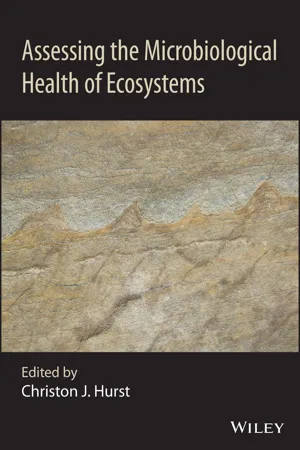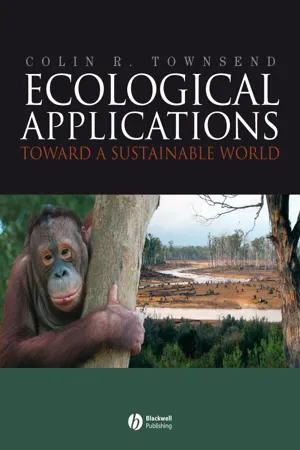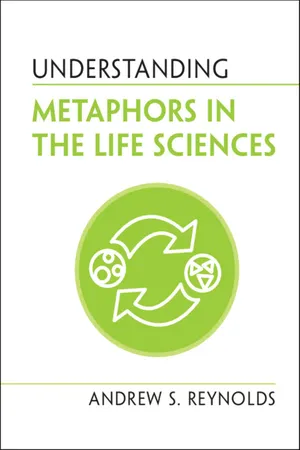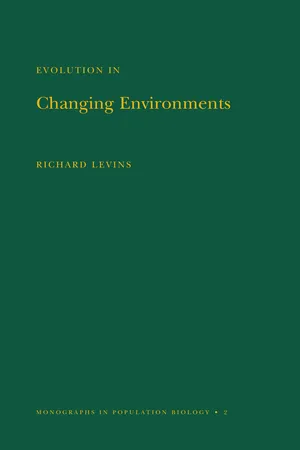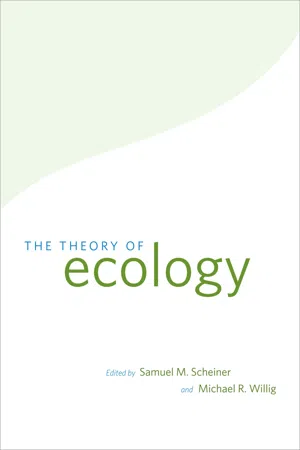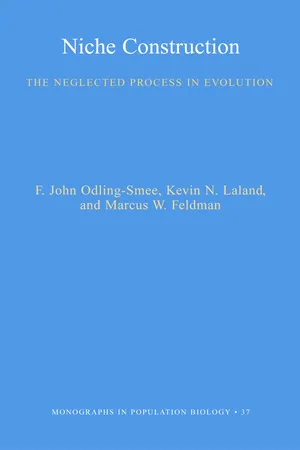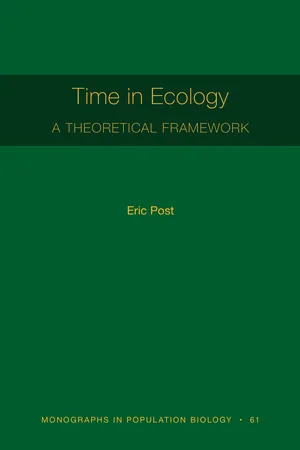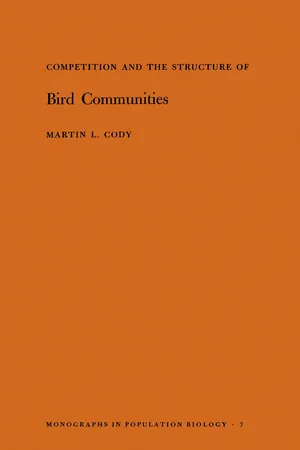Biological Sciences
Ecological Niche
An ecological niche refers to the role and position of a species within its environment, including its interactions with both biotic and abiotic factors. It encompasses the resources a species uses, its interactions with other species, and its impact on the ecosystem. Essentially, it describes how an organism fits into its ecological community.
Written by Perlego with AI-assistance
Related key terms
1 of 5
10 Key excerpts on "Ecological Niche"
- eBook - PDF
Ecological Niches
Linking Classical and Contemporary Approaches
- Jonathan M. Chase, Mathew A. Leibold(Authors)
- 2009(Publication Date)
- University of Chicago Press(Publisher)
1.2. History, Evolution, and Divergence of the Niche Concept in Modern Ecology We start with a brief history of the Ecological Niche concept. We broadly focus on the historical background, ignoring many of the finer subtleties of usage and precedence that might be of greater historical interest. The history of the niche in ecology and evolutionary biology has been already reviewed by a number of authors (e.g., Hutchinson 1957, 1978; Udvardy 1959; Whittaker et al. 1973; Vandermeer 1972; Colwell and Fuentes 1975; Whittaker and Levin 1975; Giller 1984; Schoener 1989; Griesemer 1992; Colwell 1992; Leibold 1995). The word niche (also nitch ) has been used in the English language for hundreds of years (see Schoener 1989 for some early uses of the term) and has several related meanings, most of which are not associated with biology at all. The fifth edition of Merriam-Webster’s Collegiate Dictio-nary (1959) defines niche as: “1) a recess in a wall, 2) a covert or retreat, 3) a place, condition of life or employment or the like, suitable for the capabilities or merits of a person or qualities of a thing.” The third definition is closest to how biologists view a species’ Ecological Niche. However, in the tenth edition of Merriam-Webster’s Collegiate Dic-tionary (2001) the first definitions remain, but there are two added ecological definitions: fourth, “a habitat supplying the factors necessary for the existence of an organism or species”; and fifth, “the ecological role of an organism in a community esp. in regard to food consump-tion.” It is interesting that this nonscientific dictionary has two distinct definitions of niche related to ecology and evolutionary biology: one referring to the habitat a species needs for survival, and the other refer-ring to a species’ role in or impact on the community. In fact, these definitions, although they seem superficially similar, are indicative of a similar dichotomy among ecological definitions of the niche. - Christon J. Hurst(Author)
- 2022(Publication Date)
- Wiley(Publisher)
His pro- posal has been described as the Eltonian niche, which represents the functional attributes of a species and its corresponding position in a trophic chain. 1.2.3 Evelyn Hutchinson’s 1957 Description of an Ecological Niche Evelyn Hutchinson subsequently proposed the concept of Niche Space along with the concept of biotop (Hutchinson 1957). He used the niche concept previously published by Joseph Grinnell (Grinnell 1917) which represented aspects defining where a species resides. Hutchinson did include one aspect of the eco- logical role played by members of the species, and that was an indication of the food particles consumed by members of the species. 1.3 How Does a Species Become Established in a Niche? An Ecological Niche is a function, or collection of functions, that is part of the metabolic activ- ity which occurs within a defined location. That location is the habitat. Biological life forms constantly are trying to find sources of usable energy which can sustain their meta- bolic needs and, once an opportunity for obtaining energy is found, evolution will opti- mize a biological life form to use that energy. The members of a species will need a means to physically reach and remain in reasonable proximity to their energy sources. The mem- bers of a species also will need to obtain many other resource materials, including minerals, which are necessary for sustaining the mem- bers vital functioning, because without those other resource materials the source of energy cannot be utilized. The niche of a species includes both its use of those resources plus any additional activi- ties which its members perform, including its associated physical or chemical modifications of the environment. The members of a species may have necessity for establishing beneficial working relation- ships with other species which cooperatively can help with the process of obtaining neces- sary resources.- eBook - PDF
Ecological Applications
Toward a Sustainable World
- Colin R. Townsend(Author)
- 2009(Publication Date)
- Wiley-Blackwell(Publisher)
36 2 The Ecological Niche is a summary of an organism’s abiotic tolerances and its relationships with resources and enemies – knowledge that allows managers to predict where potential invaders might do well, to choose locations for reintroductions and design reserves for endangered species, or restore degraded habitats. Chapter contents 2.1 Introduction 37 2.2 Unwanted aliens – lessons from niche theory 41 2.2.1 Ecological Niche modeling – predicting where invaders will succeed 42 2.2.2 Are we modeling fundamental or realized niches? 44 2.2.3 When humans disrupt ecosystems and make it easy for invaders 44 2.3 Conservation of endangered species – each to its own niche 46 2.3.1 Monarch’s winter palace under siege 46 2.3.2 A species off the rails – translocation of the takahe 48 2.4 Restoration of habitats impacted by human activities 49 2.4.1 Land reclamation – prospecting for species to restore mined sites 49 2.4.2 Agricultural intensification – risks to biodiversity 51 2.4.3 How much does it cost to restore a species? 52 2.4.4 River restoration – going with the flow 53 Key concepts In this chapter you will recognize that to establish and maintain a population, individuals must tolerate abiotic conditions, find sufficient resources and persist in the face of enemies see the value of Ecological Niche modeling for predicting where invaders might establish and where desirable natives can be translocated realize the risky nature of predicting niches of rare species when data are scarce understand how knowledge of the niche relations of plants can assist when planning land reclama- tion and habitat restoration appreciate that environmental management usually involves confronting economic and sociopoliti- cal as well as ecological perspectives Ecological applications of niche theory ECOLOGICAL APPLICATIONS OF NICHE THEORY CHAPTER 2 37 Kelly is a really keen angler. His friends have to smile at the sign on the door of his room: ‘Fish worship – can it be wrong?’. - eBook - PDF
- Andrew S. Reynolds(Author)
- 2022(Publication Date)
- Cambridge University Press(Publisher)
The concept of an Ecological Niche has been very influential, but has also been developed in at least two fundamentally distinct ways. One version construes the niche in largely spatial terms as the physical or environmental Figure 7.1 A literal niche. Niche with a sculpture by Antoine Coysevox, in the Les Invalides, Paris (Creative Commons Attribution Share-Alike 3.0 Unported licence; https://commons.wikimedia.org/wiki/File:Paris_-_D%C3%B4me_des_Invalides_- _Statue_-_PA00088714_-_003.jpg). 122 UNDERSTANDING METAPHORS IN THE LIFE SCIENCES space in which an organism lives; this is often known as a “habitat niche.” Another treats the niche in terms of the organism’s role in or contribution to the ecological community, and is known as a “functional niche.” Niches can be operationally defined in terms of abstract geometrical spaces wherein various biotic and abiotic factors relevant to the species are measured and represented for further mathematical analysis. A common assumption in earlier thinking about niches was that, like a physical space or an occupation in an economy, niches can exist separately from the organism that occupies it. This is an analogy quite evidently suggested by the metaphor’s source because a literal niche is an empty space that may or may not be occupied by a statue. Another assumption that appears to have been naturally suggested by the metaphor was that similar niches could exist in different environments or regions, and that a niche occupied by one species in one environment could be filled by a different species in another. For example, in the case of Darwin’s finches on the Galapagos Islands, one species of finch is described as occupying a niche typically filled by woodpeckers on the main- land, and presumably before this species began to exploit this niche by feeding on insects that live on trees and under the outer bark, the niche remained vacant. - eBook - PDF
Evolution in Changing Environments
Some Theoretical Explorations
- Richard Levins(Author)
- 2020(Publication Date)
- Princeton University Press(Publisher)
CHAPTER THREE The Theory of the Niche The concept of the Ecological Niche has been used heuristi-cally for a long time. Grinnell (1904) referred to the niches of birds to indicate that different species have different requirements. Elton (1927) used the niche mostly for defin-ing a species' position in the trophic hierarchy. Biogeogra-phers have long noted the apparent equivalence between organisms of different regions and corresponding numbers of species in corresponding formations. For instance, in Table 3.1 we show the percentages of bird species of the Maylayan and Australian rain forests in each level of the forest and for each food category. This correspondence sug-gests that the relative abundance of opportunities for species of each type, or the number niches, is the same in both forests. The notion of saturated environments versus those with empty niches has been used to compare insular and continental biotas. Finally, the classical experiments of Gause (1934) led to the exclusion principal: if two species coexist they must occupy different niches. But it was due to the work and inspiration of G. E. Hutchinson (1965) that progress has been made toward a rigorous theory of the niche. A satisfactory theory of the niche must permit an accurate description of a species' niche, and must be able to use that description to answer the following questions: 1. What determines the degree of specialization of a species, or inversely, its niche breadth? 2. What determines the species diversity of a community in relation to area, climatic region, size of organism, trophic level, etc? 3. How similar can species be and yet coexist? 4. How do similar species divide the environment among them? 39 - eBook - PDF
- Samuel M. Scheiner, Michael R. Willig, Samuel M. Scheiner, Michael R. Willig(Authors)
- 2011(Publication Date)
- University of Chicago Press(Publisher)
Ecosystems theory (Burke and Lauenroth Chapter 11) examines the fluxes of energy and nutrients through organisms and their abiotic environment. In many circumstances, the traits of species, as defined by their niches, as well as the diversity and composition of species in a community, influence the impor-tance of their roles in ecosystems. A recent application of niche theory involves species distribution modeling (often called “niche modeling”), which correlates spatiotemporal availability of broad-scale environmental features with species occurrences (e.g., Stockwell 2007). Although species distribution modeling is based on correlations be-tween distribution and environment, and is rather simplistic relative to the 5. Ecological Niche Theory 107 aspects of niche theory discussed here, it has potential to link small- and large-scale processes. Further, such distribution modeling is often used to try to un-derstand how species distributions might be altered by global change (e.g., Pe-terson et al. 2002), and thus provides important linkages with global change theory (Peters et al. Chapter 12). Conclusions Despite repeated attempts over many decades (Grinnell 1917; Elton 1927; Hutchinson 1957; MacArthur 1972; Tilman 1982; Chase and Leibold 2003), niche theory has still not fully reached its potential as a central organizing theory of ecological enquiry. This is in part due to the fact that the niche is such a hard concept to define. Indeed, any definition, verbal or mathematical, of the niche can only represent a caricature of the complexity of any species’ multivariate interactions with its environment and other species. Additionally, niche theory has not traditionally incorporated a variety of complexities, most notably spatiotemporal heterogeneities and stochasticity, which can often play an overriding role in determining the structure of natural communities. - eBook - PDF
Niche Construction
The Neglected Process in Evolution
- F. John Odling-Smee, Kevin N. Lala, Marcus Feldman(Authors)
- 2013(Publication Date)
- Princeton University Press(Publisher)
Also like Hutchinson’s Ecological Niche, our evolutionary niche has a du- ality. It refers to natural selection pressures relating to the “lifestyles” of organisms, and therefore to the many different ways in which dif- ferent organisms survive and reproduce by actively interacting with their environments, or to what Ehrlich and Roughgarden (1987) call the “occupations” of organisms. It also refers to the real habitats of organisms in real space and time, or to what Odum (1989) calls their “address.” We will again assume that the addresses of organisms can be translated from abstractions to physical realities by observing where and when organisms are found in their environments. Thus, for most practical purposes the niche of a population will be equivalent to its realized niche: that part of its fundamental niche from which it is actually earning its living, from which it is not excluded by other organisms, and in which it is able either to exclude other organisms or to compete with other coexisting organisms. We also want to capture the relativity of this niche concept by EVIDENCE 41 defining at least putative units in terms of which we can describe both how organisms relate to their environments and how environ- ments relate to their organisms. For this descriptive purpose only we will use a scheme originally proposed by Bock (1980), who assumed that any organism can be decomposed into arrays of subsystems (traits or characteristics) which he called features, and that, similarly, any organism’s environment can be decomposed into arrays of sub- systems called factors. However, to correspond with conventional use of the term “adaptation” (Rose and Lauder 1996), here we regard a feature of an organism as an adaptation only if it was favored by prior natural selection arising from one or more environmental factor. - eBook - PDF
Paleozoology and Paleoenvironments
Fundamentals, Assumptions, Techniques
- J. Tyler Faith, R. Lee Lyman(Authors)
- 2019(Publication Date)
- Cambridge University Press(Publisher)
Together these categories are sometimes referred to as comprising the BAM model (Soberón and Peterson 2005). The included variables are important ones to keep in mind because the variables most often targeted in paleoenvir- onmental reconstruction (e.g., climate, vegetation) need not be the only ones that influence where a species is found. The total variables are also important because they act in concert to determine what we perceive as the Ecological Niche of a species. A few years after Merriam developed his life zone concept and applied it in North America (Figure 2.1), ecologist Joseph Grinnell (e.g., 1914, 1917a, 1917b) suggested a species’ niche was determined by the habitat in which it lived and included its behavioral adaptations to that habitat. Ecologist Charles S. Elton (1927) adopted a more functional view of the interaction of a species with its environment. An Eltonian niche concerns both a species’ response to and its influence on the environment in which it lives. Ecologist G. Evelyn Hutchinson (1957 , 1978) discussed variables comprising Ecological Niches and the relation of those variables to areas of distribution of species (e.g., Colwell and Rangel 2009; Soberón 2007). The Hutchinsonian niche is a multidimen- sional hypervolume of environmental conditions defining the requirements for a species to exist. Figure 2.6 illustrates a two-dimensional Hutchinsonian niche of a species. The Hutchinsonian niche has now been refined to include two kinds. A species’ fundamental niche concerns the particular combination of environ- mental variables in which that species can occur; the species’ realized niche incorporates the effects of factors that preclude that species’ occurrence such that it only occurs in a portion of its fundamental niche (Graham 2005; Jackson and Overpeck 2000; Williams and Jackson 2007). - eBook - PDF
Time in Ecology
A Theoretical Framework
- Eric Post(Author)
- 2019(Publication Date)
- Princeton University Press(Publisher)
Employing this concept of the phenological niche, we may now further parti-tion it into fundamental and realized elements (Connell 1961). Recall that the fundamental phenological niche of a species consists of the intersection in a two- dimensional temporal plane of the range along one axis of the seasonal timing of abiotic conditions favorable for reproductive activity, and the range, along the other axis, of the timing of biotic conditions under which resource competition, resource acquisition, and consumer avoidance are favorable (figure 4.6, shaded region). The temporal space so delineated thus represents the potential range of conditions under which contributions to future generations are possible. The intersection in time between net favorable biotic conditions and abiotic conditions thus sets the bounds for the fundamental relative phenological niche, shown in a further idealized manner as the black oval in figure 4.7. Here, we have simply removed the nonoverlapping sections of figure 4.6 to emphasize the region T H E P H E N O L O G I C A L N I C H E 8 1 of overlap between favorable timing of biotic and abiotic conditions. Occupation of the entirety of this fundamental relative phenological niche by the individual organism, or by the species on average, is expected, however, to be limited by the abiotic and biotic conditions that actually prevail at any given site occupied by the species at any given time ( sensu Williams and Jackson 2007). The timing of such conditions may reasonably be assumed to fluctuate interannually or undergo periodic trends (figure 4.3). The intersection in time between the actualized biotic and abiotic conditions favorable to growth, survival, and reproduction by the indi-vidual thus represent the realized environmental conditions at that time and place (figure 4.7 shaded oval). - Martin L. Cody(Author)
- 2020(Publication Date)
- Princeton University Press(Publisher)
CHAPTER ONE Resource Division and the Niche I. INTRODUCTION A. Different Sorts of Field Ecology The goal of ecology is to provide explanations that account for the occurrence of natural patterns as products of natural selection. Variation at the level of the phenotype, population, or community must be related to variation in some aspect of environment; two approaches have been employed, that of experimentally induced environmental variation and the use of variation which occurs naturally in the environment. Al-though both methods achieve results, the latter, in which the ecologist gathers observational and mensural data that either discredit or support the explanations, has been obviously suc-cessful. Although lacking the definitive aspects of cause-and-effect demonstrations under controlled conditions from which experimental and manipulative studies benefit, the approach has the advantages of a rapid progression through hypothesis and theory to acceptable and accepted explanations for natural phenomena with economy of time and effort. Two further considerations have been given momentum to the acceptance of this sort of science: a great many questions and problems simply are not amenable to an experimental approach-—many ecologically interesting variables such as cli-mate, competitive milieu, foliage structure, and food level just do not lend themselves to manipulation. Even when such fac-tors are amenable to alteration, there are severe difficulties in arranging for effective controls in field situations. The obvious way around these difficulties in the experi-mental approach, and that usually adopted, is to make use RESOURCE DIVISION AND THE NICHE of the variations in environmental factors which occur natu-rally—the so-called natural experiment. Such variation does not differ conceptually from that induced by an experimenter, and may in fact be a more appropriate test in some instances.
Index pages curate the most relevant extracts from our library of academic textbooks. They’ve been created using an in-house natural language model (NLM), each adding context and meaning to key research topics.

